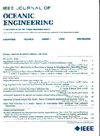海洋波导时频谱图线段检测的模型引导深度学习
IF 5.3
2区 工程技术
Q1 ENGINEERING, CIVIL
引用次数: 0
摘要
机器学习在水下声学中的应用往往受到缺乏高质量数据的限制。避免这种数据问题的一种方法是使用建模数据来训练机器学习算法,称为模型引导学习。在本研究中,开发了一种基于u - net的模型引导深度学习方法来识别海洋波导中的色散曲线。U-Net使用监督学习和海洋传播模型生成的建模数据进行训练,以检测时频谱图中的线段。基于虚警概率、检测概率、归一化互相关系数等性能指标对测试数据进行评价,U-Net有效提取了色散曲线。该网络成功地应用于未知的模拟和实验数据。我们的研究结果表明,通过模型引导的深度学习生成的色散曲线图像可以作为简洁的图像特征,包括海洋环境的信息。本文章由计算机程序翻译,如有差异,请以英文原文为准。
Model-Guided Deep Learning for Line Segment Detection in Time–Frequency Spectrograms of an Ocean Waveguide
The application of machine learning in underwater acoustics is often limited by the lack of high-quality data. One method to avoid this data issue is to use modeled data to train a machine learning algorithm, called model-guided learning. In this study, a U-Net-based model-guided deep learning approach was developed to identify dispersion curves in an oceanic waveguide. The U-Net is trained using supervised learning with modeled data generated from an ocean propagation model to detect line segments in a time–frequency spectrogram. The evaluation of U-Net with the test data, based on the performance metrics, such as probability of false alarm, probability of detection, and normalized cross-correlation coefficient, reveals that it effectively extracts the dispersion curves. The proposed network was successfully applied to unseen simulated and experimental data. Our results demonstrate that the dispersion curve images generated through model-guided deep learning can serve as concise image features, including information regarding ocean environments.
求助全文
通过发布文献求助,成功后即可免费获取论文全文。
去求助
来源期刊

IEEE Journal of Oceanic Engineering
工程技术-工程:大洋
CiteScore
9.60
自引率
12.20%
发文量
86
审稿时长
12 months
期刊介绍:
The IEEE Journal of Oceanic Engineering (ISSN 0364-9059) is the online-only quarterly publication of the IEEE Oceanic Engineering Society (IEEE OES). The scope of the Journal is the field of interest of the IEEE OES, which encompasses all aspects of science, engineering, and technology that address research, development, and operations pertaining to all bodies of water. This includes the creation of new capabilities and technologies from concept design through prototypes, testing, and operational systems to sense, explore, understand, develop, use, and responsibly manage natural resources.
 求助内容:
求助内容: 应助结果提醒方式:
应助结果提醒方式:


